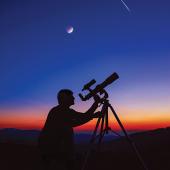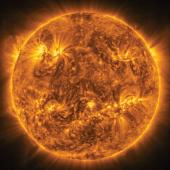Steering by the Sky
Let’s say you’ve been kidnapped—God knows why. You’re tossed into a trunk, driven an interminable time, and dropped off in the middle of nowhere with only a jacket, a bottle of water, and two sticks of gum. Night is falling. What do you do?
Put on the jacket. Save the water for later. Pop one of the sticks of gum into your mouth. Then look at the sky.
Sky orienteering is one of those lost arts that once were part of an average human’s survival kit, telling you where and when you were and what you ought to do about it. Today, such time-and-space navigation is one of the taken-for-granted gifts we all get via watches, GPS units, smart phones, and those smart-alecky voices that order us around in our cars. But unused skills atrophy, and knowing something about how to find your way around the sky—and how it can help you find your way around on the ground—is more than a Boy Scout merit-badge activity; it’s a way to appreciate something of our sky heritage, and it can still serve as a quick orientation exercise.
How to Find Directions
Back to our scenario: you chew thoughtfully, searching the sky as the stars pop out. You’re looking for something familiar—the seven medium-bright stars of the Big Dipper, four outlining the saucepan-like bowl, three the crooked handle. There! It’s dark enough now that you’ve spotted it, hanging nearly overhead. You trace an imaginary line through the Pointers, the bowl stars farthest from the handle, from the bottom through the top star and beyond… until you hit another medium bright star. That’s Polaris. It’s called the North Star for good reason: it sits nearly over the North Pole of the Earth, and as the Earth spins, it pretty much stays put. It seems motionless. And it marks the direction North.
You face it. Your nose is now pointing north, your bum south. Stretch out your arms, and your right hand points east, your left west. With the cardinal directions sorted out, you’ve got your first piece of data to get yourself out of your predicament.
How to Determine Latitude
You can use the North Star to determine your latitude roughly, as well. Stretch out your hand and spread your thumb and pinky; the distance between the two is about 15 degrees of sky. Measure up from the northern horizon to the North Star, and the number of degrees of Polaris’ altitude equals your latitude. So if Polaris is about three hands up—which is halfway between the horizon and the point directly overhead—you’re around 45 degrees longitude and still at the latitude of southernmost Montana.
How to Tell Time
The Big Dipper circles once around the Pole Star in one 24-hour Earth rotation, which means you can also use it as a big clock in the sky to mark the passage of time. It’s spring, so the Dipper is high in the sky at the beginning of the night. (As the seasons shift, its early evening position shifts as well; in the fall, for instance, it will hang low above the horizon in the early evening.) As you plod west toward a light bubble you figure is Bozeman, you keep an eye on the Dipper; when it’s circled an eighth of the way around Polaris, three hours have gone by; a quarter of the way equals six hours. It’s said that cowpokes riding herd at night in the days of the Old West used the Big Dipper similarly as a timepiece; when the pattern had circled through the requisite arc, it was time to go roust your pardner out of his bedroll to take his shift with the cattle.
It’s a common story—all through human history, star positions have told people things. As the Earth circled the sun and the star patterns shifted through the seasons, they announced seasonal events. The appearance of Sirius, the brightest star in the sky, rising just ahead of the sun, told the ancient Egyptians that the Nile was about to flood, bringing silt to fertilize their fields. Three thousand years later, the same event may have told the builders of the Big Horn Medicine Wheel, some of whose cairns seemed aligned to the star’s rising, that summer was ending and it was time to wrap up their ceremonial activities before the snows came.
For the Navajo, the position of the Rabbit Tracks (the stars marking the stinger of what we call Scorpius the scorpion) announced the hunting season. When the stars tipped to aim eastward in the evening, the period during which young animals still depended on their mothers was concluded, and the hunt could begin.
When the Polynesian canoe voyagers ranged the Pacific hunting for islands, the stars could guide them home. The bright spring star Arcturus, for example, passed directly over the Hawaiian Islands with the nightly turning of the sky. By sailing until the star was passing over their canoe, the voyagers knew they were at the latitude of Hawaii; then, all they had to do was to sail west with the trade winds until the islands came into view.
And so it was through all of history—until now. But we still steer by the stars in our modern endeavors in particular ways. The Mercury, Gemini, and Apollo astronauts all trained in planetariums in stellar navigation, in order to steer their space capsules should their navigation systems fail. And many of our space probes carry star trackers, sensors placed to detect certain bright stars so the spacecraft know their orientation in space.
Gizmos fail. But the stars are constant. Learn how to use them, and they can be a backup system to help you navigate your way through the world.
Jim Manning is currently executive director of the Astronomical Society of the Pacific in San Francisco, but lived outside Bozeman for many years and visits regularly.












